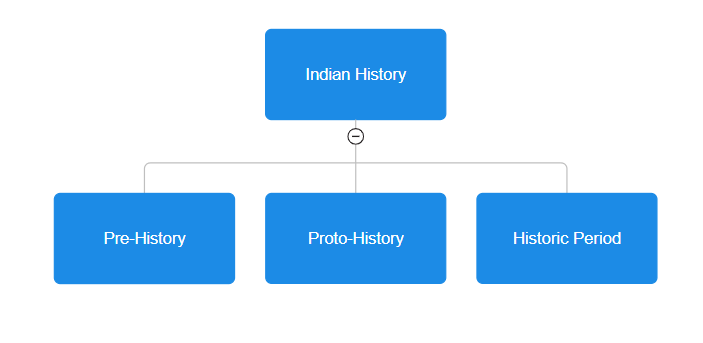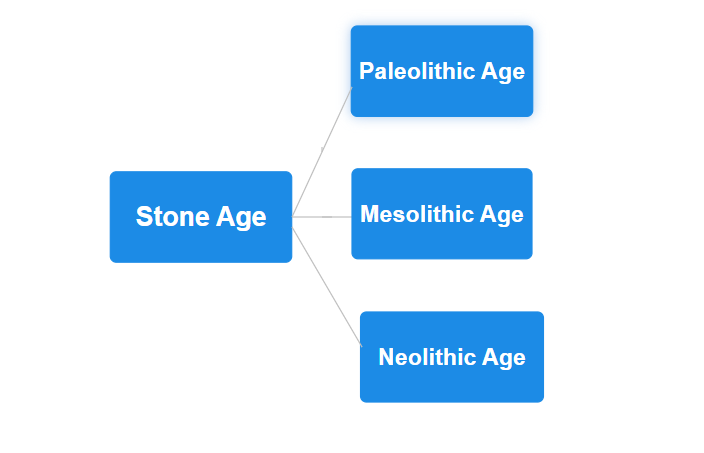CT Entrance: The Stone Age marks the beginning of human life on Earth. It is a crucial topic for the D.El.Ed Entrance Exam, as 2-3 questions are frequently asked from this section. This period saw the invention of basic tools, the discovery of fire, the domestication of animals, and the beginning of agriculture.
Let us explore this important phase in a simple and comprehensive manner.
CT Entrance: Division of Ancient Indian History
Historians divide Indian history into three broad periods:

Pre-History:
No written records are available of this period.
- Only archaeological discoveries are the source of knowledge about this period.
- It Includes the Stone Age and the beginning of agriculture.
Proto-History:
Scripts were used that time and they have been discovered, but they haven’t been deciphered yet.
- Example- Harappan Civilization
Historic Period:
Written records and inscriptions are available.
It starts from around 600 BC.
CT Entrance: What is the Stone Age?
The Stone Age is the earliest period of human history. It gets its name because at that time humans made tools and weapons mainly from stone. The period is important as it shows the gradual evolution of humans from hunter-gatherers to settled farmers.
In India, the Stone Age is divided into three phases:

Palaeolithic or Old Stone Age (100000 – 10000 BC)
The term “Palaeolithic” comes from Greek word ‘Palaeo’ meaning “old stone.”
- It was basically hunting and gathering culture.
This was the longest phase of the Stone Age.
Fire was discovered at that time, and early humans lived in caves or rock shelters.
Palaeolithic age in India is further subdivided into 3 following phases:-
Lower Palaeolithic (100000–50000 BC):
Use of heavy stone tools are seen at that time.
Sites: Soan Valley, Bhimbetka, Attirampakkam.
Middle Palaeolithic (50000–40000 BC):
Tools were sharper and smaller, mostly made of flakes.
Sites: Narmada Valley, Tungabhadra River areas.
Upper Palaeolithic (40000–10000 BC):
Appearance of Homo sapiens (modern humans).
Use of bone tools, sewing needles, and harpoons.
Early signs of art and symbolic thinking.
Mesolithic or Middle Stone Age (10000 – 7000 BC)
It is the transitional phase between the Palaeolithic and Neolithic age and has also known as Late Stone age.
People still hunted and gathered food but also domesticated animals.
- Plant Cultivation had been started at this age.
- Use of advanced small tools called Microliths.
Fishing began, and people started semi-permanent settlements.
Domestication of Animals: Dogs, sheep, and goats.
Cave Paintings: Better artistic expression (Bhimbetka, Mirzapur).
Burial Practices: Dead were buried with grave goods.
Site State Significance Bagor Rajasthan Largest Mesolithic site in India Adamgarh Madhya Pradesh Evidence of early dog domestication Langhnaj Gujarat Burial sites with skeletal remains
Neolithic or New Stone Age (7000 BC onward)
- The Neolithic age marked the beginning of food production.
- It also witnessed the domestication of animals and cultivation of plants.
- First Domesticated – Dogs,Goats , Sheeps.
- Wheat and Barley were first grown crops.
- They knew the art of producing Fire by Friction.
- Wheel was discovered at this age.
People built mud houses, often circular or rectangular in shape.
They made polished stone tools, such as axes and sickles.
Pottery was introduced — first handmade, later on foot-wheels.
| Site | Present State |
|---|---|
| Mehrgarh | Baluchistan (Pakistan) |
| Burzahom | Jammu & Kashmir |
| Paiyampalli | Tamil Nadu |
| Chopani Mando | Uttar Pradesh |
| Nagarjunakonda, Hallur | Andhra Pradesh & Karnataka |
Quick Revision of Stone Age ( CT Entrance)
Stone Age = Prehistoric Age.
Divided into: Palaeolithic, Mesolithic, Neolithic.
Microliths = Mesolithic.
Agriculture begins = Neolithic.
Mehrgarh = Oldest Neolithic site.
Bhimbetka = Rock shelters and paintings.
First tools = Stone (later copper in Chalcolithic).
Neolithic Pottery = Handmade → Foot-wheel → Black-grey ware.
The Neolithic people of Mehergarh were more advanced. They produced wheat,cotton and lived in mud brick houses.As they were producing food they needed pots cooking, eating and drinking. Hence, pottery was first appeared in this age.Later they used foot-wheels to make pottery.Mehrgarh is one of the oldest known Neolithic sites in the Indian subcontinent.
Previous Year CT Entrance Questions
Which site is known for the earliest evidence of rice cultivation?
Answer: Allahabad
What type of tools were used in the Mesolithic Age?
Answer: Microliths
Which Neolithic site is famous for pit dwellings?
Answer: Burzahom (Kashmir)
Written by: LearnOdisha.com – Simplified Learning for Teaching Careers
Also read – CT Entrance Cut off










